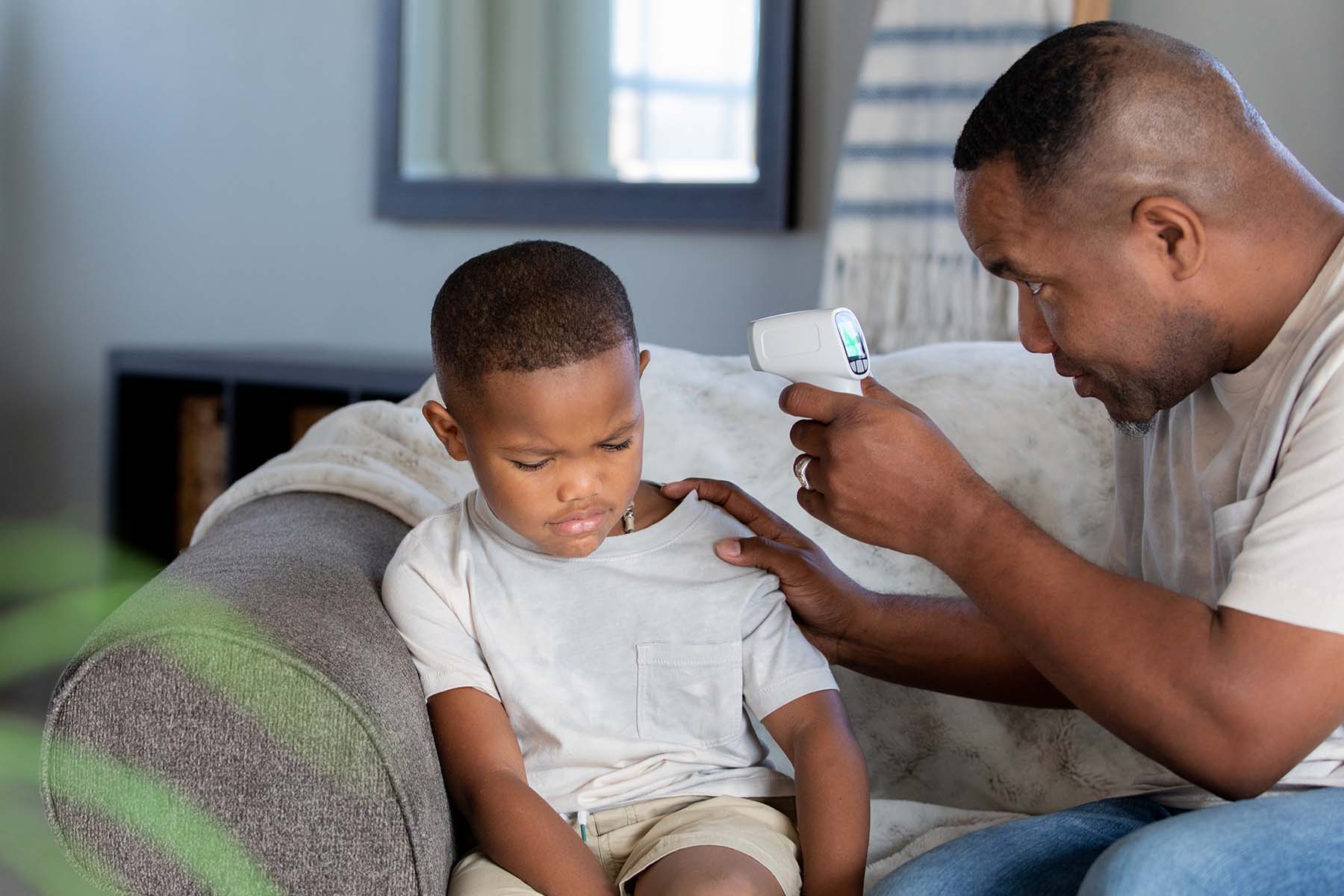What Germs Are Coming Home With Your Child?

Back-to-school season means more than new pencils, crayons, and lunch boxes. It’s not just homework children bring home from the classroom. Through no fault of their own, kids who are in close contact with other kids inevitably become walking, talking vectors of infections.
Parents, however, can prepare to combat those bacterial and viral infections. To that end, we’re providing a handy reference to eight of the most common childhood cooties:
The Common Cold
The symptoms are familiar: coughing and sneezing, sore throat, stuffiness and sometimes a mild fever. Unfortunately, a cold is hard to avoid but relatively simple to treat. Make sure your child drinks plenty of fluids and gets lots of rest. You can address some more bothersome symptoms with age-appropriate, over-the-counter medication.
Never give children aspirin, however, as it is known to trigger Reye’s Syndrome in kids.
Be forewarned: “Once they start school, children, especially younger ones, seem to have a cold all the time,” says Nicole S. Torres, a mother of two and a pediatrician at the University of Miami Health System.
“What happens is that a cold lasts 7 to 10 days, and then they may have a week or a few days where they’re fine before they catch another cold. There are so many cold viruses that we can’t just build immunity to all of them.”
What to watch out for: A fever that spikes above 102 degrees or that lasts for more than four or five days. This could signal something more serious. Consult your pediatrician if your child exhibits prolonged or high fever or worsening symptoms.
Dr. Torres tells parents to follow the American Academy of Pediatrics guidelines: If a 2-year-old or young child has a 103 fever persistently for more than 24 hours, if they are 3 years or older with a high persistent fever, of if the fever breaks but the child is still looking unwell or cranky, call the doctor.
Also, be attentive to ear pain complaints. Some ear infections result from a cold; a doctor can tell if the ear infection needs specific treatment. Recurrent ear infections may also require more aggressive interventions.
The Flu (Influenza)
Like the common cold, the flu comes with a sore throat and coughing, even congestion, but there are some notable differences between the two.
Because it tends to be more severe, flu sufferers experience higher fevers and sometimes vomiting and diarrhea, as well as chills and body aches, which are not part of the common cold. Symptoms also come up abruptly and not gradually, like the common cold.
The good news is that influenza vaccinations are highly effective.
Even if you catch a flu strain, the illness will be less severe.
What to watch out for: Children with asthma, diabetes or other serious underlying disease who display flu-like symptoms should always be seen by their pediatrician or other regular physician.
In healthy kids, if there is a persistent high fever, labored/ fast breathing or any worsening of symptoms, Dr. Torres advises parents to err on the side of caution and also contact the child’s doctor. Every year, children die of the flu; most of these are kids with underlying conditions.
Stomach flu
Certain bugs can cause serious tummy aches — not to mention vomiting and diarrhea. Some have also been known to bring on a low fever, even muscle aches. Thankfully, most stomach bugs clear up within 24 hours.
The best treatment, Dr. Torres says, is rest and lots of fluids.
Your child likely will not want to eat, so it’s best to wait until the nausea subsides. Do not give the child Imodium — “It can actually make things worse.” While Pepto-Bismol chewable tablets for children (never give a child the adult version) don’t treat the vomiting and diarrhea, it can help with reflux or stomach upset.
“Start with clear fluids and build up slowly,” she says. “And hydrate, hydrate, hydrate.” In addition to water, a child can also drink the tried-and-true Pedialyte.
What to watch out for: Be on the lookout for dehydration. Telltale signs of this condition are infrequent peeing, unusually concentrated urine, dry mouth, and cracked lips. If the vomiting is so severe that the child cannot hydrate, check in with the doctor. If the watery stool has any blood, also consult the doctor.
If symptoms last for more than 24 hours, also phone the doctor.
Fifth Disease
This is caused by parovirus B19. Its proper name is erythema infectiosum, but it got labeled with its common moniker because it turned out to fall fifth in a classification list of common childhood skin rashes.
Symptoms sometimes include fever, headache and runny nose, but its most revealing sign is a rash on the cheeks — or the “slapped cheek rash” that might also develop on the body. The rash and other symptoms usually go away on their own. Joint pain and/or swelling is rare but can happen.
What to watch out for: While usually mild in healthy children, it can be problematic for a pregnant woman’s fetus. A pregnant woman should avoid exposure to a child with this rash.
Strep throat
Caused by a bacteria called group A Streptococcus, strep affects the throat and tonsils and is highly contagious. Along with sore throat and a fever, children usually experience pain with swallowing. Their neck glands may be painful or swollen, and they may also complain of a headache and stomach ache. They typically do NOT have respiratory symptoms (runny nose and cough).
It’s more common in older school-aged children than in younger ones. Ensure this is not a cold or another viral illness – the child needs to be tested by the doctor. If it is strep, the doctor will prescribe antibiotics.
What to watch out for: While serious complications are not common, the bacteria can spread to other parts of the body and cause several issues.
These include sinus infections, ear infections, swollen lymph nodes, rheumatic fever (a disease that can affect the heart, joints, brain, and skin), or post-streptococcal glomerulonephritis (a kidney disease).
Respiratory syncytial virus (RSV)
RSV is a common childhood infection that has been in the news a lot. Like so many other respiratory viruses, its symptoms include coughing, sneezing, runny nose, and fever.
In most school-age children, it tends to be mild, but it can lead to serious consequences in infants and the elderly.
RSV can be managed with such over-the-counter medications as acetaminophen or ibuprofen and lots of fluids. In addition, the U.S. Food and Drug Administration recently approved an RSV vaccine for kids. The CDC recommends one dose of nirsevimab for all infants younger than 8 months and two doses for immunocompromised babies between 8 and 19 months.
What to watch out for: If a baby, particularly an infant six months or younger, has trouble breathing or is visibly wheezing, immediately contact the doctor. They may need hospitalization. Serious symptoms can be alleviated with additional oxygen or mechanical intubation.
Pink eye
Conjunctivitis is that yucky eye irritation that reddens the white part of your eye and sometimes makes your lids stick together. It also tends to cause a discharge and a sensitivity to light. There are three types of conjunctivitis: viral, bacterial and allergic.
This is definitely a go-see-the-doctor kind of infection, says Dr. Torres.
It’s the only way of determining which kind of conjunctivitis you have. If it’s bacterial, the doctor will prescribe antibiotics.
The viral kind is the most common, and it’s also highly contagious. Unfortunately, a patient has to ride it out until it clears. As for allergic conjunctivitis, it is best dealt with by removing the allergen that causes it, usually pollen or pet dander. Some swear by home remedies of cold compresses and artificial tears to alleviate symptoms.
What to watch out for: While a viral infection usually clears up in in one or two weeks without serious consequences, some severe viral conjunctivitis can take longer and may require special antiviral medications prescribed by a doctor.
What’s more, because it’s so contagious, schools will not allow children back into the classroom until symptoms are completely cleared. Bacterial infections should show improvement after 24 hours of antibiotics.
Kids should be taught not to touch their eyes with unwashed hands. Also, infected children should not share pillows, towels, washcloths, makeup or brushes, or any kind of contact lens or eyeglass equipment.
Head Lice
Those creepy crawlies are annoying, but, as Dr. Torres explains, “they don’t carry disease, and they don’t jump from head to head. All they can do is crawl.”
In short, these tiny insect nuisances will only give you the itchies.
Nevertheless, they’re common, especially among elementary-age kids, and rare is the year when a school doesn’t experience an infestation.
There are plenty of effective over-the-counter medications, and Dr. Torres tells parents to be vigilant about removing the bugs in their many forms, including nits or eggs, nymphs and louse.
Watch Out For: Other family members run the risk of playing host to these little buggers, so check everyone’s scalp and hair carefully. Also, wash the infected child’s towels, hats, bedding, plush toys, and clothing.
Some schools require no-lice proof, so check before sending your child back to school.
Though these childhood infections are common, we have weapons to combat them. Good hand hygiene, getting plenty of sleep and eating nutritiously help us prime for battle. She also refers parents to the American Academy of Pediatricians’ website, www.healthychildren.org, for quick and easy reference.
“Our bodies,” Dr. Torres concludes, “are well equipped to fight off infections. We can deal with most of these without a real problem.”

Ana Veciana-Suarez is a regular contributor to the University of Miami Health System. She is a renowned journalist and author who has worked at The Miami Herald, The Miami News, and The Palm Beach Post. Visit her website at anavecianasuarez.com or follow @AnaVeciana on Twitter.
